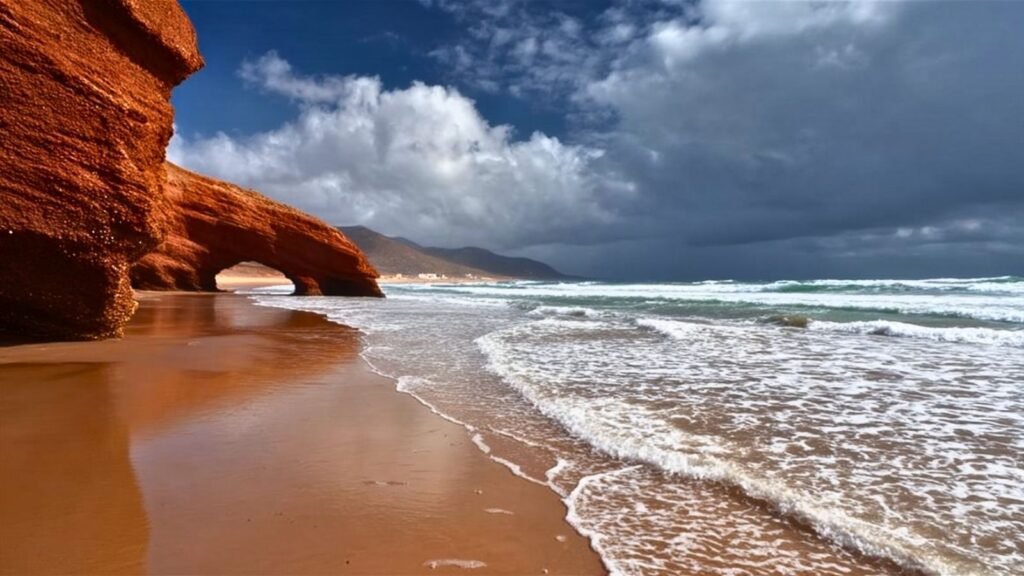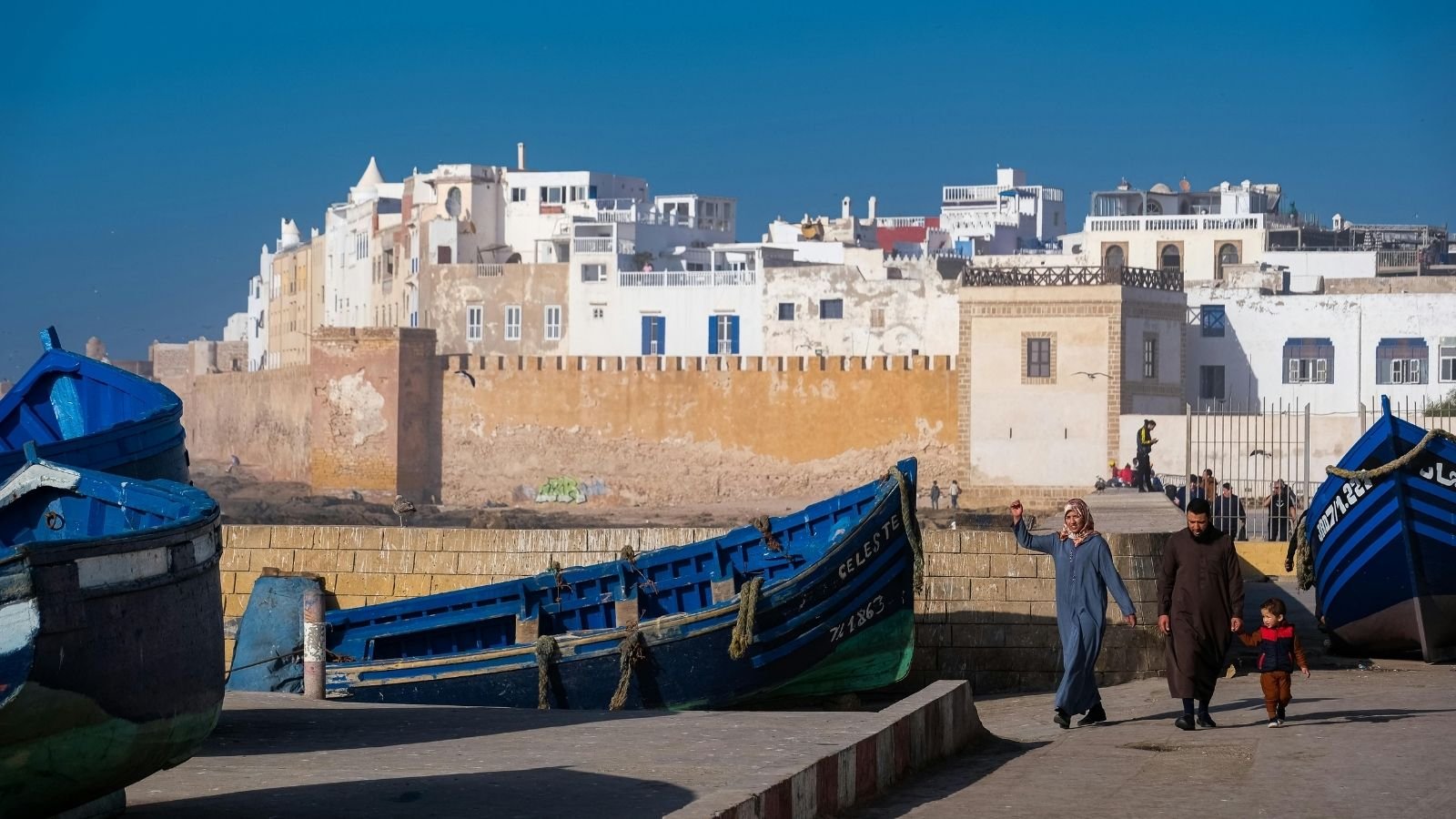Let’s talk about coastal towns in Morocco. There’s something irresistible about Morocco’s coastline. Maybe it’s the Atlantic breeze mixed with sea spray and the faint scent of grilled sardines. Maybe it’s the tangle of medinas just steps from the beach, or the fact that time seems to forget these places exist. Whatever the alchemy, it works. If your idea of paradise is a lazy afternoon with the soundtrack of crashing waves and the occasional donkey bray drifting through the air, you’re in for a treat. This isn’t the polished Mediterranean, all sleek yachts and sun loungers in formation. This is Morocco’s coast—weathered, whimsical, and wonderfully unpredictable. It’s the kind of place where you arrive with grand plans and find yourself cancelling them all because the tide is in and your book is just getting good. The pace is Mediterranean but with a Moroccan twist—slightly saltier, a bit earthier, and far more interesting.
Let’s talk about Essaouira first, because of course we are. This breezy Atlantic town might be the most charmingly windswept place in North Africa. It has that rare mix of history, atmosphere and just enough eccentricity to keep you entertained without tipping into kitsch. Jimi Hendrix allegedly wandered its ramparts in the sixties, looking mildly confused and entirely at home. Or maybe that was just a local in round sunglasses. Either way, the legend persists. The medina is a maze of whitewashed alleyways, blue shutters, and cats so self-possessed they might be running for local office. Walk through the souks and you’ll find silver jewellery, hand-carved thuya wood boxes, musical instruments, and the odd painting that looks suspiciously like it was done during someone’s gap year. And the best part? No cars. You actually hear your footsteps echo as you meander. It’s the kind of town that gives you permission to wander aimlessly and still feel like you’ve accomplished something.
The harbour is pure theatre. Blue fishing boats bob like corks, seagulls scream overhead, and fishermen haggle over crates of glistening sardines while tourists try not to get in the way. You can stroll along the ramparts of the Skala de la Ville, where rusting cannons still point towards a sea that long ago stopped attacking. It’s a view you’ll want to bottle. The beach itself is a windsurfer’s paradise, though if your idea of fun doesn’t involve holding on to a giant kite for dear life, you’ll be perfectly happy sipping juice at Ocean Vagabond and watching the pros make it look easy. And if you’re lucky, there’s a guy with a camel who will let you pose for a photo that’ll make your friends question your life choices. If you stay long enough, even that seems completely normal.
Come evening, Essaouira turns golden. The sky flares in pinks and oranges, and every street corner seems to smell like grilled calamari or cinnamon pastries. Hit the fish grills near the port for a seafood platter that’s equal parts delicious and chaos, or duck into a riad for a more refined tagine experience. There’s also gnawa music drifting from somewhere at almost any hour, hypnotic and soulful, like a lullaby from another time. And if you get caught in the rain—which does happen occasionally—it’s just another excuse to find shelter in a tea house and order pastries you weren’t planning on eating. One minute you’re buying a scarf, the next you’re being taught how to play the guembri.
Further down the coast lies Mirleft, which feels like someone decided to build a town entirely out of siestas and sea air. It’s small, understated and charming in a quietly rebellious sort of way. No massive resorts, no loud beach bars, just a series of cliffside walks and windswept beaches that feel like they’ve been forgotten by everyone except the locals and a few well-informed nomads. Legzira Beach is the main act, its red rock arches once Instagram royalty, now slightly less photogenic after a partial collapse, but still very much worth the trip. Bring a sandwich, stay for the light show. And if you find yourself wondering if it’s too quiet—you’re doing it right. Mirleft is what happens when stress gives up trying to follow you.

You won’t find much nightlife in Mirleft unless your idea of wild is a mint tea with extra sugar, but that’s part of the draw. Local cafés dish up omelettes and msemen, and surf schools run casual lessons for those inclined to fling themselves into the Atlantic repeatedly. You’ll get bruised, you’ll laugh, and you’ll earn your dinner. Accommodations are intimate—think family-run guesthouses with terraces and cats in every sunbeam. Spend a few nights here and your sense of time begins to shift. Mornings blend into afternoons, and to-do lists become increasingly irrelevant. Even checking your phone starts to feel like an imposition. And if you’re lucky, a local might invite you to a beach bonfire with music that goes on until the stars start whispering.
Drive a bit further south and you’ll stumble into Sidi Ifni. It’s a former Spanish outpost that seems stuck in a hazy, tropical daydream. The architecture still wears its colonial history—Art Deco buildings that could be film sets if they weren’t so delightfully peeling. The town has a whiff of end-of-the-line melancholy, but it’s also strangely magnetic. Wander the market on a Sunday and you’ll find everything from vintage radios to goat cheese to questionable plastic sandals. Grab a seat at a café on the main square and watch the world dawdle by. Or take a slow walk along the cliffs at dusk, where the views are so cinematic you half expect credits to roll. If you’re feeling adventurous, strike up a conversation with a fisherman and you may end up on a boat with no itinerary and the freshest lunch you’ve ever had.
Now swing back north and you’ll find Oualidia, the calm eye of Morocco’s coastal storm. It curves around a saltwater lagoon so picturesque it looks like it was commissioned by a tourism board and then left untouched for decades. Flamingos strut about as if they own the place, fishermen drift in blue rowboats like characters from a children’s book, and the water sparkles just enough to make you question your life choices up until this point. You can rent paddleboards, float aimlessly, or spend the day napping on a terrace without anyone judging you. The town smells faintly of seaweed and salt and grilled oysters—a perfume no one sells, but someone absolutely should.
Oysters are the main event here. Not optional, not even negotiable. Order a dozen at a shack overlooking the lagoon and marvel at how something so simple can be so smugly satisfying. Ostrea II is a favourite for a reason—no frills, just glorious shellfish and a killer view. You can also kayak, swim or simply sprawl with a book while the tide shuffles in and out like a well-trained butler. Hotels range from ultra-chic (hello, La Sultana) to humble guesthouses that serve soup you’ll remember three months later. If you’re the kind of person who gets genuinely excited about seeing herons and reading for hours, you’ve found your bliss. And if you’re not, give it an hour. You will be. There’s a gentle rhythm to Oualidia, one that insists you slow down whether you planned to or not.
For a bit of drama with your downtime, head to Asilah. Close to Tangier but a world away in mood, this walled town is an artist’s sketchpad made real. Every summer, it hosts a mural festival that turns its medina into a kaleidoscope of street art, all backed by 15th-century Portuguese ramparts and the crash of waves beyond. It’s tidy, it’s tranquil, and it’s got just the right amount of bohemian spirit without descending into cliché. Think of it as the lovechild of an artist’s retreat and a beach holiday. Time here isn’t measured in minutes but in shadows, breeze patterns, and the number of mint teas consumed.
The beach here is long and languid, and the sunsets are the kind that make you reevaluate your camera roll. Port XIV is where you go when you want seafood and mood lighting, but you’ll find charm in every nook—like the crêperie run by someone’s aunt or the antique shop where you could accidentally spend an hour arguing over a teapot. There’s no rush. Time saunters in Asilah. It’s all slow sips, long shadows, and meandering thoughts. Even the cats seem to walk with purpose—probably to their next siesta. If you’re lucky, you’ll stumble upon a poetry reading or a pop-up gallery that feels more like a secret shared among friends.
Still need convincing? Imagine a place where you can start the day with fresh bread and honey, ride a camel (or at least take a photo next to one), lounge on a beach without ever hearing a jet ski, and fall asleep to the sound of waves and your own breath slowing down. That’s Morocco’s coast. Not glossy, not manicured, but honest and endlessly endearing. If your ideal break includes sea breezes, crumbling ramparts, endless tagines, the occasional goat on a cliff and absolutely no pressure to do anything at all, you’re in exactly the right place. Bring a good book, a forgiving hat, and a vague plan you fully intend to abandon. Bonus points if you leave your watch behind and learn the fine art of doing nothing very well indeed.
